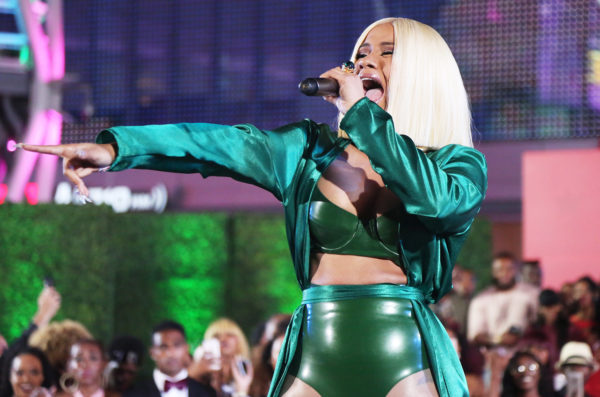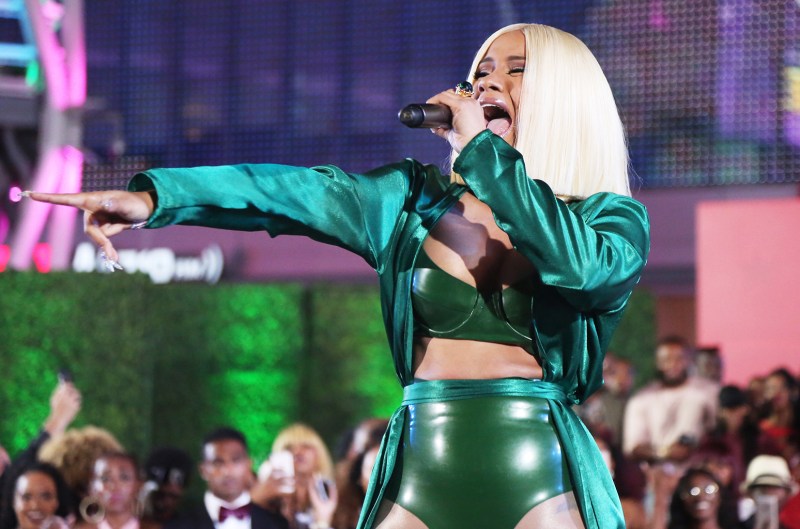
The pop charts have been boring this year. There’s no way to sugarcoat it, no other adjective to describe a year where “Shape of You” and “Despacito” ruled the top spot on the Billboard Hot 100 chart for 28 of the 41 weeks of the pop year so far. This is not a statement on the quality of these songs — “Shape” and “Despacito” are, respectively, on the bad and good ends of mediocre — but merely a judgment on how little movement there’s been in the upper reaches of the chart. Interesting things have happened in the top 10, of course — the ascendancy of Kendrick Lamar and Migos from critical and street favorites to bona fide superstardom and the arrival of a new wave of rappers like Lil Uzi Vert, Post Malone and 21 Savage both feel like real shifts in the pop/rap ecosystem. Nevertheless, these pockets of engaging story have been largely drowned out by the tropical house-lite of Ed Sheeran or Luis Fonzi and Daddy Yankee’s pop-reggaeton.
Enter Cardi B. As of the October 7 edition of the Billboard Charts (the charts are postdated — the October 7 edition corresponds to songs played on radio, bought, and streamed in roughly the week of September 17), Cardi B’s debut single, “Bodak Yellow” is the number one song in the country. It dethrones Taylor Swift’s “Look What You Made Me Do,” a truly dire song that seemed to occupy the top spot on the chart by a sort of popular inertia — a hit not because it’s a good, or even listenable, song, but because it’s by a mega-famous pop singer that people talk about a lot. That Swift single ascended to number one nearly immediately, setting various streaming records, but “Bodak Yellow” took a much longer and circuitous journey, mirroring Cardi’s own path.
Cardi B sounds like no one else on the radio right now. In a pop moment where pop singers typically subsume their styles into the aggressively nondescript sounds of EDM producers like Zedd, Kygo and the Chainsmokers and rappers tend towards a slurry, Future-and-Migos inspired Southern trap sound, regardless of where they’re actually from, Cardi B sounds like a figure from another era. Born Belcalis Almanzar, Cardi B, who is Trinidadian and Dominican, was raised in the Bronx and Washington Heights, and she sounds like it. Her aggressive, almost bleating voice is the most New York-sounding rap voice to top the charts in a long while, evocative more of late 90s rappers like Lil’ Kim and Foxy Brown than the current crop of prominent rappers.
While New York rap never died, rappers like Joey Badass, Action Bronson and A$AP Ferg have achieved some degree of success with more traditionalist approaches to the style and stars like A$AP Rocky and Nicki Minaj blended hometown style with Southern influences — it’s been a while since a rapper this blatantly New York has topped the pop charts. The beat here — a riff on Florida rapper Kodak Black’s “No Flockin,” whose name also inspires the song’s title — is a fairly standard trap track, but the star of the show is Cardi, who takes a hyper-confrontative, straightforward approach, immediately setting her apart from most of the other pop-rap hits this year. The difference is most apparent on the song’s remix, which brings on Kodak Black — where Kodak slithers and rasps his lines, Cardi is right in your face the whole time.
The hard-nosed magnetism that Cardi shows off on “Bodak Yellow” makes sense — it’s a riff on the persona that has taken her from a performing arts school in the Bronx to rap stardom, with a few bouts of fame in the worlds of stripping, social media and reality shows. Cardi B rose to fame in the New York club ecosystem around 2014, aided by her near-simultaneous rise to social media notoriety on Vine and Instagram. Cardi B’s social media posts from 2014 and 2015 offer an early view into the bold, charismatic persona on display in her music — she’s funny, vulgar and seemingly completely unfiltered — in one, she hits back at those who claim that stripping isn’t a real job by asking “How the fuck we buying weaves, then? How the fuck we buying ass shots, hah? With fake money from our fake job?”
By late 2015, her fame as a social media influencer, a sort of psuedo-celebrity that gets paid to promote various things on Instagram and Twitter, allowed her to leave stripping behind. Around the same time, Cardi became a central part of the VH1 reality show “Love & Hip-Hop: New York,” quickly becoming the breakout star of the show’s sixth and seventh seasons. Her rise to prominence on television allowed her to pursue her music career, releasing her first mixtape, “Gangsta Bitch Music Vol. 1” in March 2016. From then, her rise was first steady — she appeared on digital cover of Vibe magazine, a hip-hop institution, in November 2016 and signed to Atlantic Records in February of this year — and then meteoric, starting with the release of “Bodak Yellow” in June.
It’s that song that turned Cardi B from a New York rap curiosity to perhaps the biggest new rapper of 2017. “Bodak Yellow” isn’t a perfect song — its beat is a generic, maddeningly repetitive trap loop that’s mostly just an excuse for Cardi to air her grievances, and Cardi’s flows aren’t particularly inventive — but it is a perfect showcase of Cardi’s appeal, condensed into 224 seconds of braggadocio. “Bodak Yellow” is mostly a celebration of her come up — she doesn’t have to “dance” anymore because of the “money moves” she’s making — but the specific details she chooses, the references to how she “fixed her teeth” and how her rolex looks like “frosted flakes” reveal the same honesty and comic sensibility that brought her social media fame.
It’s in this persona-first style that Cardi sets herself apart. While all pop stars are defined by the identities they construct for themselves — “Look What You Made Me Do,” the song that “Bodak” displaced at the top of the charts, exists essentially only as a hamfisted attempt by Taylor Swift to change the narrative surrounding her — many pop stars either are forced into an identity by a record label or come into a defined identity only later in their careers, only after wallowing in generic pop tropes. Cardi B took the opposite route, coming to music with a clearly defined, charismatic persona as her main selling point. Where other rappers have had to shave off their rougher edges to reach the top 10 — witness fellow New York rapper French Montana’s faceless hit single “Unforgettable,” which hit number 3 on the Hot 100 and sounds like an average of every other rap hit from the past 12 months — Cardi B’s edges are the point. “Bodak Yellow” couldn’t have been made by anyone other than Cardi B, and that’s enough reason to celebrate its place at the top of the charts.
Contact Jacob Kuppermann at jkupperm ‘at’ stanford.edu.
